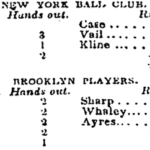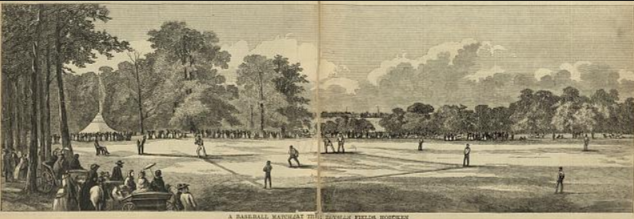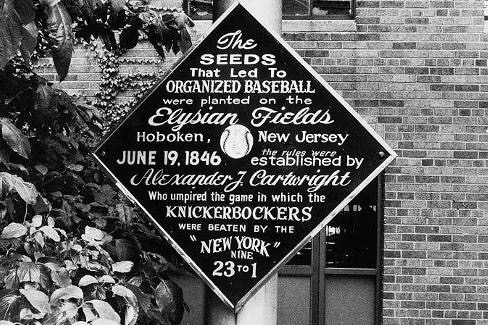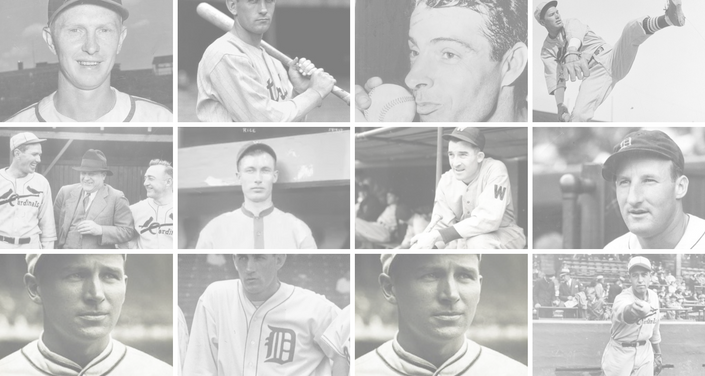Alexander Cartwright Essentials
Born: April 17, 1820 in New York, NY USA
Died: July 12, 1892 in Honolulu, HI USA
Hall of Fame: Inducted as a Pioneer/Executive in 1938 by Centennial
Full Name: Alexander Joy Cartwright
Alexander Joy Cartwright was born in New York City on April 17, 1820. He left school at the age of 16, and worked as a bank teller from 1843 until 1845, as well as a volunteer fireman in the city. After the bank burned down, he and his brother, Alfred, opened a book and stationery store.
In 1842, Cartwright and a group of other young men had begun playing town ball, an early version of baseball, on a vacant lot at 27th Street and 4th Avenue in Manhattan. In 1845, the lot became unavailable for use, and the players located a new playing grounds, known as Elysian Fields, across the Hudson River in Hoboken, New Jersey.
Elysian Fields, a tract of about five acres that stood surrounded by woods, provided an ideal setting . In order to pay the annual rent of $75 for the grounds, Cartwright organized a ball club, with dues to be contributed by its members. The Knickerbocker Base Ball Club of New York was formed on September 23, 1845. Its name was probably in tribute to Knickerbocker Engine Company No. 12, the fire station where Cartwright and some of his teammates worked.
The Knickerbockers were primarily a social club. Their membership, limited to forty, was dominated by men in the professions, business, and white-collar jobs who played base ball on Mondays and Thursdays after work.
The club appointed a four-man committee to draft a constitution and by-laws. Cartwright and the committee’s president, Daniel L. “Doc” Adams, were primarily responsible for the by-laws, which became baseball’s first formal rules. Cartwright is also believed to have been the first person ever to diagram a diamond-shaped baseball field.
It is not known to what extent the new rules enshrined the existing practices of town ball, and which were the innovations of Cartwright and Adams. But the Knickerbocker code declared that there were to be three bases and a home plate, with 90-foot basepaths between them. It assigned each player to a specific position, thus implying that there would be nine men on a side. Players were required to bat in a set rotation, with three outs to an inning. If a batter, or “striker” as he was called, swung at and missed three pitches he was out, provided the last pitch was received by the catcher “either flying or upon the first bound” (bounce). If it was not, the batter could try to reach first base.
The Knickerbocker rules did away with the old practice of “soaking” or “plugging”, in which a batter was retired by hitting him with a thrown ball as he ran. A batter would now be put out by throwing the ball to the base ahead of him, or touching him with the ball. He was also out if a foul ball was caught on the fly or on the first bounce, or if a fair ball was caught on the fly. Once the pitcher made a move to deliver the ball, he had to throw it; he could not feint or fake a pitch. A game was won by the first team to score 21 runs, with equal innings to be played, affording each side the same number of chances to bat. Finally, there could be no appeal from an umpire’s decision.
In what is regarded as the first official baseball game, the Knickerbockers played a team called the New York Base Ball Club on June 19, 1846 at Elysian Fields, using the newly-formulated rules. The Knickerbocker uniforms featured blue woolen pantaloons, white flannel shirts and straw hats. Alexander Cartwright did not play in the game, but served as umpire, and fined one player six cents for swearing. The New York Base Ball Club, a loosely-organized group that actually included some Knickerbocker players, won by the final score of 23 to 1 in a game that lasted four innings.
Demand by other clubs for the new rules was lively. The Knickerbockers had one hundred copies printed for distribution, and allowed the club’s secretary to list his address in the “Sunday Mercury” newspaper. The specifications gained general acceptance as the “New York game”, and their use spread to the South before the Civil War. In 1860, they became part of the National Association of Baseball Players Rules, a code that slowly evolved into the regulations governing the game today.
Alexander Cartwright was soon caught up in the fever of the gold rush, and left for California on March 1, 1849, never to see New York again. He took a baseball with him, and as he crossed the country by train, wagon, and on foot he spread the word about the burgeoning sport and the Knickerbocker rules at every opportunity.
Cartwright arrived in San Francisco in August, 1849, only to find that the gold rush was largely over. He helped establish baseball in the city during his six-week stay, before sailing to Hawaii, then known as the Sandwich Islands.
Delighted by the beauty of Hawaii, Cartwright began to organize and teach the game of baseball throughout the islands. The leagues he formed in Hawaii eventually became the models for the modern-day American and National Leagues.
Cartwright never returned to the mainland. Settling in Honolulu, he served as the city’s fire chief from 1850 until 1863, while the businesses he founded made him a wealthy man. He held several government positions, and helped establish Hawaii’s library system and one of its foremost hospitals. An adviser to Hawaii’s King Kalakaua and Queen Emma, he was also the executor of the Queen’s last will and testament. He continued to promote the growth of baseball in the islands until his death on July 12, 1892, at the age of 72. Today, a street and a park in Honolulu bear his name, and his grave site in the city has been visited by many famous ballplayers, among them Babe Ruth.
In 1938, Alexander Cartwright’s service to the sport was recognized with his election to the Hall of Fame. On June 3, 1953, the United States Congress officially credited him with inventing the modern game of baseball.








